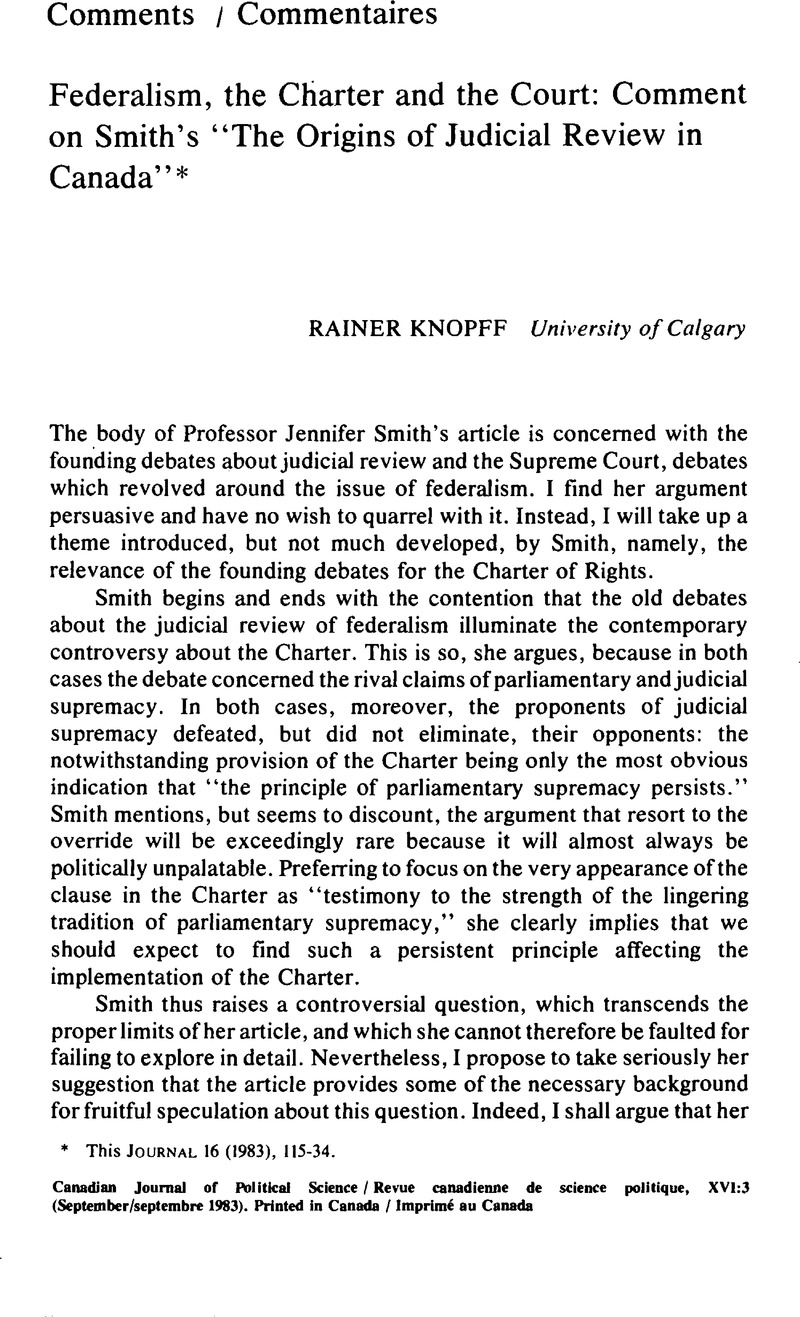Article contents
Federalism, the Charter and the Court: Comment on Smith's “The Origins of Judicial Review in Canada”*
Published online by Cambridge University Press: 10 November 2009
Abstract

- Type
- Comments/Commentaires
- Information
- Canadian Journal of Political Science/Revue canadienne de science politique , Volume 16 , Issue 3 , September 1983 , pp. 585 - 591
- Copyright
- Copyright © Canadian Political Science Association (l'Association canadienne de science politique) and/et la Société québécoise de science politique 1983
References
1 For a discussion of the origin and adequacy of this modern definition of federalism, see Diamond, Martin “The Federalist's View of Federalism,Google Scholar” in Benson, George C. S. et al., Essays in Federalism (Claremont: Institute for Studies in Federalism, 1961).Google Scholar
2 See Knopff, Rainer“Legal Theory and the ‘Patriation’ Debate”, Queen's Law Journal 7 (1981), 42–46.Google Scholar
3 For a theoretical discussion of the importance of the Rule of Law and an independentjudiciary to the protection of human rights, see Orwin, Clifford and Pangle, Thomas L.“Restoring the Human Rights Tradition,” This World 1 (1982), 21–27.Google ScholarIn Canada, Roncarelli v. Duplessis [1959], S.C.R. 121, is a dramatic example of these principles in action.Google Scholar
4 See Scigliano, RobertThe Supreme Court and the Presidency (New York: The Free Press, 1971), 23–35;Google Scholar and McCloskey, Robert G.The American Supreme Court (Chicago: University of Chicago Press, 1960), 36–48.Google Scholar
5 Hamilton, AlexanderMadison, James and Jay, JohnThe Federalist Papers, ed. by Clinton Rossiter (New York: Mentor Books, 1961), 322.CrossRefGoogle Scholar
6 Elliott, Ward E. Y.The Rise of Guardian Democracy: The Supreme Court's Role in Voting Rights Disputes. 1945–1969 (Cambridge, Mass.: Harvard University Press, 1974), 51.CrossRefGoogle Scholar
7 Ibid..,48.
8 See Scigliano, The Supreme Court and the Presidency, 36.Google Scholar
9 Wilson, James Q.American Government: Institutions and Policies (Lexington: D. C.Heath, 1980), 517.Google Scholar
10 Elliott argues that “the real difference between the intervention of the Warren Court in suffrage questions and the nonintervention of the Taney Court is not so much the adoption of the Fourteenth Amendment as the victory of the Union in the Civil War, which gave the Court a federal power base without which its additional jurisdiction would have been useless” (The Rise of Guardian Democracy, 51).
11 See Cairns, Alan“The Governments and Societies of Canadian Federalism,” this JOURNAL 10 (1977), 695–725;Google Scholar and Simeon, Richard “Regionalism and Canadian Political Institutions,”Google Scholar in Schultz, Richard et al. (eds.), The Canadian Political Process (3rd ed.; Toronto: Holt, Rinehart and Winston, 1979), 293–301.Google Scholar
12 In oral argument before the court in Regina v. Westendorp, a case challenging the validity of Calgary's anti-prostitution by-law. When lawyers attempted to invoke the Charter, Chief Justice Bora Laskin retorted, “Let's leave the Charter aside for the moment. Most of you seem so mesmerized by it, you've forgotten division of powers.” Eventually, the lawyers abandoned the Charter argument (“High Court Moves Cautiously on Charter,” Calgary Herald, December 4, 1982).
13 Scigliano, The Supreme Court and the Presidency, 200–01. According to Scigliano's calculations, legislation which is struck down by the court is almost always shaped primarily by Congress and not the President.Google Scholar
- 1
- Cited by


